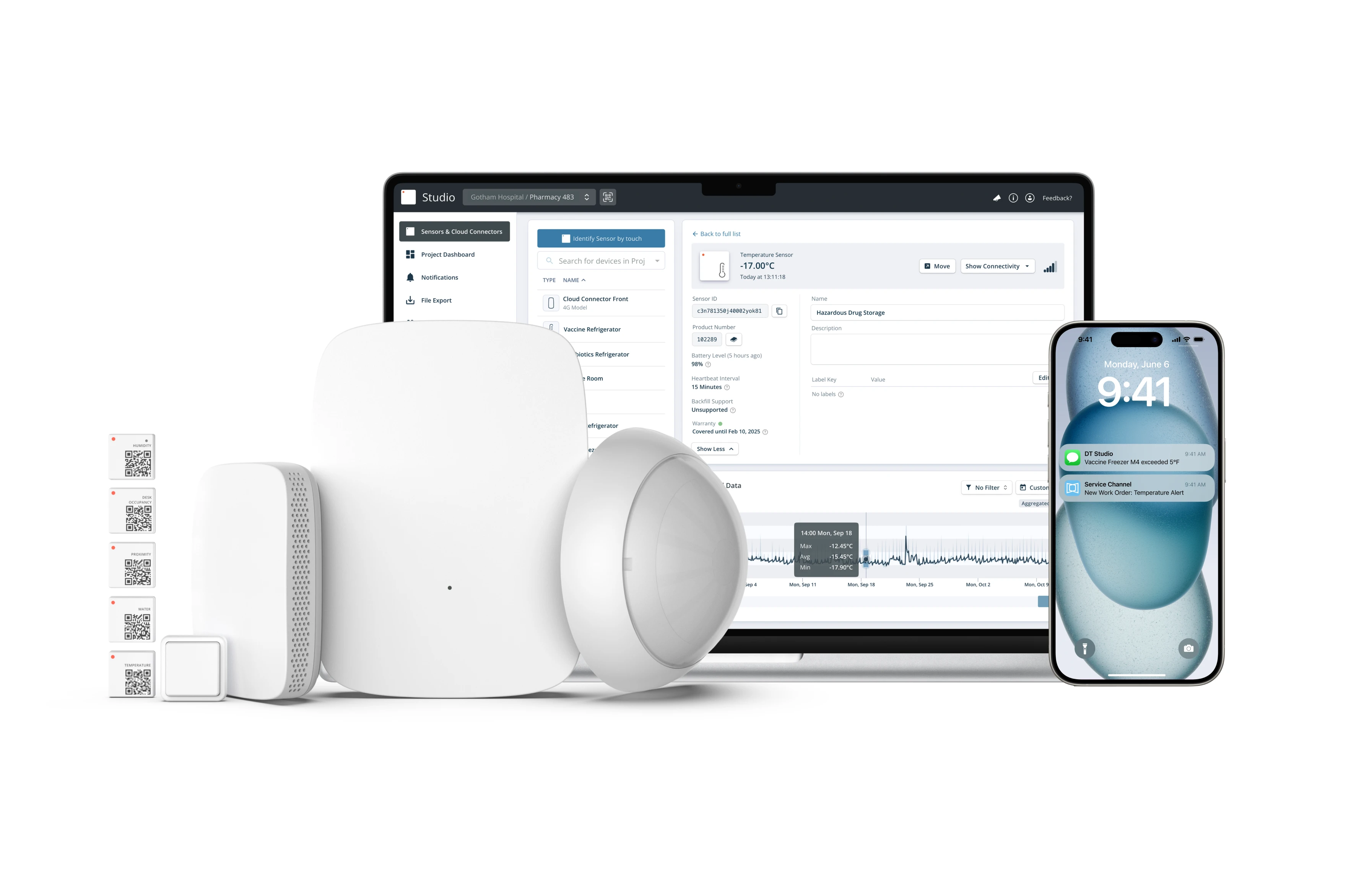How Do Humidity Sensors Work & What To Do With Them

What Are Humidity Sensors?
Humidity sensors are electronic devices that measure and report the moisture and air temperature of the surrounding environment where they are deployed e.g., in air, soil, or confined spaces.
Humidity measurements indicate the concentration of water vapor presented in the air. They provide their measurements in the form of a proper electronic signal. Moreover, they also report relative humidity i.e. the ratio of moisture in the air to the maximum moisture at a given temperature.
Relative humidity is useful for many applications, like HVAC (Heating Ventilation Air Conditioning) and comfort optimization applications in Smart Buildings and Facilities Management.
State of the art humidity sensors provide support for internet connectivity and can be flexibly deployed in the Internet of Things (IoT) applications. This facilitates the integration of humidity measurements with the output of other sensors (e.g., temperature sensors) and boosts IoT applications intelligence in various industry applications.
The quality of a humidity sensor is reflected in its accuracy, reliability, response time, longevity, security, robustness, and ease of deployment. These characteristics also determine the sensor’s cost. Furthermore, they drive the selection of humidity sensors for different applications.
Humidity Sensor: Use Cases & Where To Place Them
Humidity sensing enables a host of value-added use cases in a variety of industries, including cold storage management, comfort optimization, asset condition tracking, and remote monitoring.
Humidity Sensors in Cold Storage Management
In the area of cold storage management, humidity sensing ensures proper storage conditions for temperature-sensitive products such as food, beverage, and pharmaceuticals.
Humidity sensors contribute to regulatory compliance and to automating the auditing of the status of the equipment. In conjunction with temperature sensors, they also contribute to increasing product safety, while reducing waste.
Overall, the combination of temperature sensors and humidity sensors in cold storage management enables the development of very powerful tools for regulatory compliance, automation of audits, increased product safety, and improved environmental performance.
Humidity Sensors in Smart Buildings & Facilities Management
In smart buildings, humidity sensors are deployed to improve the comfort offered to tenants and occupants. For example, they provide insights on the moisture conditions of certain rooms, which can subsequently drive the fine-tuning of the rooms’ conditions through the Building Management System (BMS).
By adding humidity sensors to HVAC systems and office environments, Facilities Managers can efficiently monitor, measure, and adjust humidity to provide a comfortable and productive working environment. In many cases, humidity sensors are used to enhance temperature monitoring functionalities towards increased comfort and fine-tuning of energy consumption.
Beyond comfort, humidity sensing is essential to ensuring proper conditions for valuable assets. For example, galleries, museums, and art collectors can maintain stable environmental conditions for their collections. For this purpose, they should keep track of humidity changes, as moisture can be catastrophic for paintings, drawings, prints, mosaics, and sculptures. Humidity monitoring helps galleries and museums protect their assets and lower their insurance costs.
Humidity Sensors in Remote Monitoring and Intelligent Asset Management
Humidity sensors are also integral elements of remote monitoring and intelligent asset management use cases. They can be deployed on assets (e.g., pumps, compressors, fans, data centers) to facilitate a transition from preventive to predictive maintenance.
Specifically, humidity sensor data streams can enhance the accuracy of predictive analytics for condition-based monitoring. They also enable the real-time monitoring of humidity to identify problems (e.g., potential leakages) before they occur. In these ways, humidity sensors extend the lifetime of critical assets and maximize their overall efficiency.
In many cases, humidity sensing is used in conjunction with other types of sensing (e.g., temperature, proximity, touch, water) to offer additional value-added services in smart buildings and facilities management contexts. Complete sensing solutions help set Facilities Managers apart from their competitors.
Disruptive Technologies Humidity Sensor: Basics, Usage, and Applications

In response to the market’s demand for increased intelligence in Cold Storage, Smart Buildings, and Facilities Management services, Disruptive Technologies (DT) has recently added a humidity sensor to its portfolio of novel sensing solutions. The new sensor has been released following extensive testing and validation in pilot environments. It provides the means to monitor relevant humidity in the atmosphere. DT’s humidity sensor is available to the mass market and ready to scale.
The sensor is available in two variants, one for the European Union and one for the United States. Touch functionality makes installation very simple, which allows customers to start monitoring humidity and enjoy its benefits immediately.
DT’s robust sensing solutions provide several unique selling propositions, which enable innovative solutions that offer exceptional intelligence:
- The sensors have the size of a postage stamp and enable real-time sensing in a variety of settings.
- Water and dust resistant IP-68 rated design
- Our battery-enabled sensors have a lifetime of up to fifteen years.
- We offer exceptional security, thanks to DT’s patented end-to-end security scheme from the sensor to the cloud, which eliminates weak points and known IoT vulnerabilities.
- DT’s sensing solutions can be flexibly integrated into sophisticated IoT applications. The integration is scalable, yet very simple, leveraging on the functionalities of DT’s web-application, Studio, and DT’s Cloud Connectors
Studio facilitates sensor programming based on visual drag-and-drop interfaces and the development of application logic in mainstream platforms like Python. Likewise, Cloud Connectors enable the connection and integration of thousands of sensors, which minimizes installation complexity and allows future proof scalability.
The simplicity, scalability, and robustness of DT’s sensors enable the development of non-trivial solutions at a very compelling Total Cost of Ownership. The recent addition of the humidity sensor in our portfolio provides opportunities for more versatile and intelligent solutions. This is part of our continuous commitment to deliver the most innovative sensing solutions in the market.

Easy-to-Deploy IoT Sensors & Infrastructure
Content That Might Interest You
Get Started




.png)
